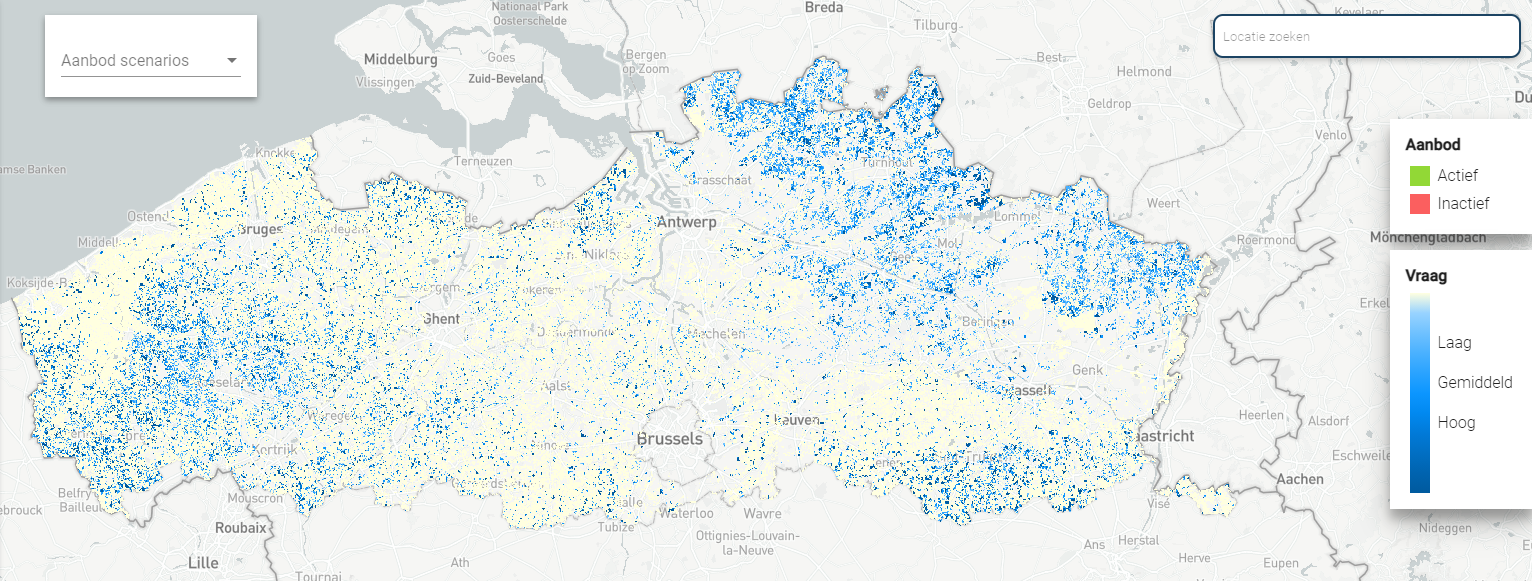On the occasion of World Water Day (Monday 22 March), Inagro, ILVO, VITO and Vlakwa are launching the online viewer WaterRadar (www.waterradar.be. With this tool, farmers and growers can easily look for suitable alternative water sources in the vicinity of their parcels. Specifically, the focus is on both treated household wastewater from Aquafin plants and on treated wastewater from food processing plants. In addition, interested companies and local authorities can use this tool to gain insight into the theoretical irrigation requirements on a regional scale.
Active and inactive water sources
To help farmers and growers find their way to alternative water sources, the online viewer WaterRadar (www.waterradar.be) was developed. By entering a location or address in the search function, growers can easily find out what alternative water sources are available nearby. Among other things, the viewer shows the address and contact details of the water provider, as well as the average available daily quantity (expressed in m3) and the chloride concentration of the water offered.
In order to be able to offer treated wastewater for agricultural applications, both Aquafin treatment plants and food processing companies must have a raw material declaration. The green companies in the WaterRadar are locations that have such a raw material declaration. They are therefore legally in order to offer water. Red companies, on the other hand, do not offer water today. But what is not possible today, may be possible tomorrow.

The WaterRadar provides a general view of theoretical water demand at a regional scale. This map is based on the occurring crops from the most recent collection application and a rough estimate of the area-specific irrigation demand per crop. (© WaterRadar)
Theoretical irrigation demand visualized for 2020
The WaterRadar visualizes not only the water supply, but also the theoretical irrigation need on a regional scale. To this end, the project partners mapped the crops present on the plots all over Flanders for 2020. For each crop (group) they then made a rough estimate of the extra irrigation need for the entire growing season, on top of the natural precipitation. They assumed a normal weather pattern (and thus not the extremes of the past three years). The map shows at a glance in which regions the potential water demand is highest.

The WaterRadar provides a general view of theoretical water requirements at a regional scale. This map is based on the occurring crops from the most recent collection application and a rough estimate of the area-specific irrigation demand per crop. (© WaterRadar)
Companies that want to offer water to farmers and horticulturalists can use the WaterRadar to verify the potential demand for water in their region. Local governments can consult the WaterRadar to gain knowledge about regional irrigation demand. In this way, local projects can be initiated that better match water supply and demand, thus facilitating sustainable and circular water use.
Current irrigation demand at plot level for potato, cauliflower and spinach plots
To better estimate the actual irrigation need at field level, the partners of the VLAIO project Irrigation 2.0 are also working with soil moisture sensors, satellite images, weather forecasts and a crop growth model. Growers will soon be able to monitor the current irrigation needs of their fields with cauliflower, spinach and potatoes themselves via the online platform WatchITgrow. The AquaCrop model will be integrated for this purpose. That computer model from the United Nations Agriculture and Food Organization (FAO) can quickly and easily predict the water needs of crops, taking into account the type of crop, soil texture and weather forecasts.
Before that model can provide reliable irrigation recommendations, it must be calibrated for the situation in Flanders. Reliable data on the moisture and crop condition on various practical plots are crucial for this. That is why Inagro and ILVO are intensively monitoring the soil moisture and crop development of various field plots of cauliflower, spinach and potatoes also in 2021.
Water quality requires the necessary attention
To map the long-term effects of irrigation with alternative water sources, Inagro has been conducting irrigation trials since 2019 in which spinach, cauliflower and potatoes are irrigated under controlled conditions. The irrigation water comes from an Aquafin plant and from the frozen vegetable and potato processing sector. Inagro closely monitors the quality of the supplied water, as well as its impact on the soil.
After two years of irrigation trials, the conductivity (EC value) and the salinity (sodium and chloride) of the water appear to be the important concerns, both to minimize the effect on soil quality and the impact on the crop. It is clear that intensive irrigation with water with an EC higher than 4500 µS/cm can result in leaf burn and increased soil salinity. Attention to the conductivity and salinity of alternative water sources is therefore necessary. Agricultural or horticulturalists who have questions about this can contact Inagro at klantenservice@inagro.be.
Text: TIM DE CUYPERE, Charlotte Boeckaert (Vlakwa), Anne Gobin (VITO), Willem Coudron (ILVO),
The VLAIO LA project Irrigation 2.0: When where what water? started on October 1, 2018 and will run for 4 years. Inagro is coordinating the project, working with ILVO, the Flemish Institute for Technological Research (VITO) and the Flemish Water Knowledge Center (Vlakwa). The research is funded by the Innovation and Enterprise Agency and various co-funders.
